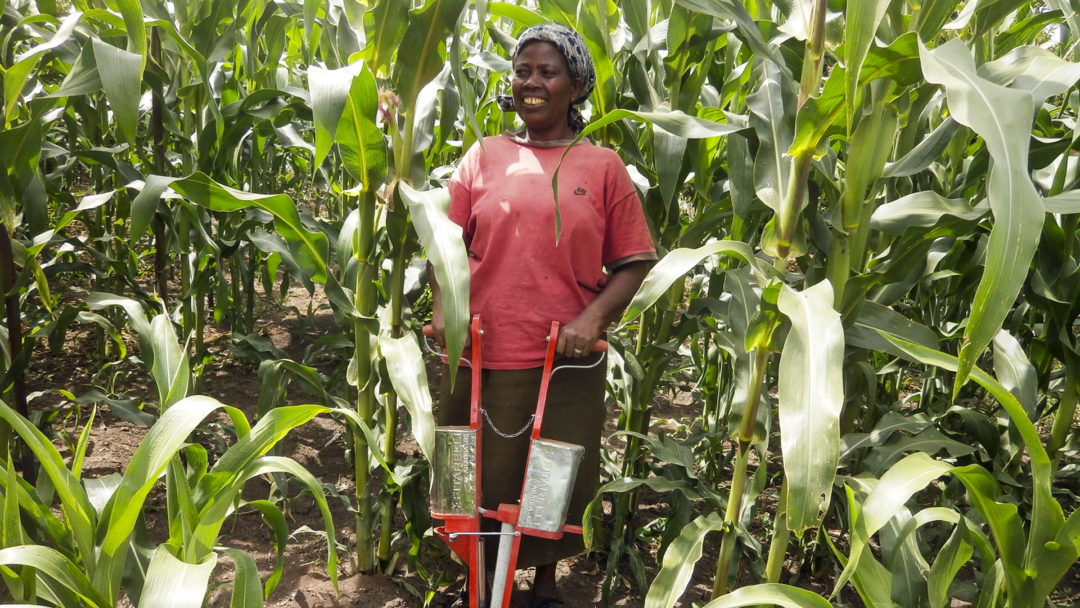Before switching to no-till, Kenyan farmer Pauline Mughambi had trouble feeding her two children from the yields on her 1 acre of land.
The retired accountant-turned-farmer is located in Nakuru County, about 96 miles northwest of Nairobi, Kenya’s capital. Despite putting countless hours into tilling her land, Mughambi either had too little or too much moisture with conventional tillage, and her harvests were poor.
Mughambi told Zenger News that she was about to give up farming, but she changed her mind when she discovered no-till.
“I fell in love with conservation farming after attending a farmers’ day organized by FAO [Food and Agriculture Organization] in 2016,” Mughambi says. “Since that day, I have never looked back.”
Mughambi harvested 13 bags of corn in her first year of no-tilling, more than double the 6 bags she’d typically get from conventional tillage. Now, she’s harvesting 36-40 bags in a typical year. Her no-till beans, sweet potatoes, vegetables, bananas and fodder also are giving her good returns with less work.
With more than enough food to feed her family, she’s been able to sell her surplus as her main source of income. She’s also putting money back in her pocket by spending less on her no-till system. Her 1 acre used to cost her about $300 to till and fertilize, but now she’s only spending about a quarter of that. The savings and extra income have allowed her to put her two kids through university, build a home and buy five dairy cows.
Mughambi has become a champion for no-till in Africa and around the world. In 2018, she won the Eastern Africa Conservation Agriculture Award, and she represented small farmers in Africa at the Eighth World Congress on Conservation Agriculture in Switzerland in 2021.
Thousands of Kenyan farmers have learned about no-till through an FAO project introduced in 2007. As of 2018, approximately 26,000 farmers from 18 regions of Kenya have been trained on and are practicing no-till. The organization’s goal is to put 10% of Kenya’s farming population under conservation agriculture. About 47% of Kenya’s land, or 68.3 million acres, is used for agriculture, according to FAO data. A study from 2018-19 estimated that 8.2 million of those acres are no-till.
Albunus Mutisya, a no-tiller in Tharaka Nithi County 111 miles east of Nairobi, transformed 2 acres from drought-ridden, low-yield fields to a model no-tillage farm. The area is semi-arid with very little rainfall to fully sustain crop growth, Mutisya says, but mulching and no-till helps conserve enough water to grow first maturing and drought-resistant crops.
“Conservation farming transformed my farm into a food and money-making farm,” Mutisya says. “Every farmer around here is adopting this style of farming because it has tangible results, and we have moved from being food donation receivers to suppliers.”
Practical field examples from Tharaka Nithi, Makueni and Kitui counties — all counties initially classified as food insecure — show that minimum tillage can increase yields by 300%, says Richard Munang, the regional climate change coordinator for the United Nations Environmental Program Africa. By adopting no-till, farmers have been able to turn Kenya’s arid and semi-arid regions into food-sufficient communities.
Read more about no-till in Kenya in this article from Zenger News.
Related Content:
Kenya’s Dryland Farmers Embrace Regenerative Farming to Brave Tough Climate: After embracing the regenerative agriculture technique, 52-year-old Justus Kimeu is looking forward to a bumper harvest of maize as all his neighbors count their losses following this year’s failed season.
Helping Zambia Reach its ‘Huge’ Farming Potential: A longtime Australian no-tiller and former speaker at the National No-Tillage Confernce is playing a major role in an organization determined to help Africa adopt modern farming methods.
Conservation Ag Shining in Zimbabwe: The government of Zimbabwe is working to train nearly 2 million farmers in conservation agriculture (CA) and 1 million farmers have already been trained in the country.
The No-Till Passport series is brought to you by Martin Industries.
Since 1991, Martin Industries has designed, manufactured and sold leading agriculture equipment across the U.S. and Canada. Known for Martin-Till planter attachments, the company has expanded to include a five-step planting system, closing wheel systems, twisted drag chains, fertilizer openers and more in their lineup. Their durable and reliable planter attachments are making it possible for more and more farmers to plant into higher levels of residue.








